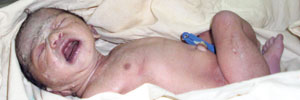 Propped up on a bed with a few tubes linking her to machines, H.M. Dinithi Chathurika is all smiles. Although she has not held her first-born close, she knows that her baby daughter is well. Propped up on a bed with a few tubes linking her to machines, H.M. Dinithi Chathurika is all smiles. Although she has not held her first-born close, she knows that her baby daughter is well.
“We haven’t named her yet,” says 21-year-old Chathurika from Badalkumbura, explaining nekath balala ne (they haven’t checked the auspicious times and the letters for her name).
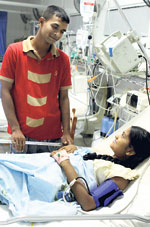
Relieved parents: Chathurika and Dhanushka (above) and (top) laparotomy in progress |
Outside the Intensive Care Unit of the Castle Street Hospital for Women, both Chathurika’s husband, K.M. Dhanushka Sampath and mother, D.K. Kusumawathie are relieved. For not only the baby-girl but also Chathurika are doing fine.
Childbirth -- what’s extraordinary about that? Millions of women give birth to babies every day.
Chathurika’s pregnancy and delivery, however, were different. “The baby grew in the abdominal cavity and not the womb (uterus),” says Consultant Obstetrician and Gynaecologist Dr. Tilak Dissanayake in charge of Ward 7 and 8, stressing that it is a “rare situation”.
Usually, when the mother’s egg or ovum and the father’s sperm fuse in the fallopian tube of the mother, the embryo falls into the uterus and gets implanted there. However, in Chathurika’s case, the embryo may have slipped out of the fallopian tube which has a very thin wall and implanted itself in the other structures of the abdominal cavity outside the womb, the Sunday Times understands. Where a fertilized egg is implanted in any tissue other than the uterine wall it is called an ectopic or extra-uterine pregnancy which is generally life-threatening to the mother. Ectopic pregnancies commonly take place in the fallopian tubes.
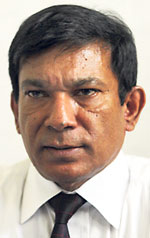
Dr. Tilak Dissanayake |
It was Visiting Obstetrician and Gynaecologist Dr. Prasad Wickremesinghe of the Moneragala Hospital who diagnosed Chathurika’s rare pregnancy after a scan and contacted Dr. Dissanayake immediately, seeking his help for the delivery.
Smilingly adding that Dr. Wickremasinghe is one of his golayas, Dr. Dissanayake says that soon after the diagnosis, Chathurika was transferred to the Castle Street Hospital on June 23 where he and his staff of Ward 7 and 8 took over her care. It was a serious situation where both the lives of the mother and baby were in danger.
The special test -- a Magnetic Resonance Imaging (MRI) scan was then carried out not only to locate the exact position of the foetus and the placenta but also to make sure that when the medical team opened up the abdomen they would not cut any blood vessels which would result in haemorrhaging. The placenta called the after-birth is a temporary organ rich in blood vessels that joins the mother and foetus for the transfer of oxygen and nutrients from the mother to the foetus and permits the release of carbon dioxide and waste products from the foetus.
The team also requested the Gastroenterologist from the National Hospital to be on hand when Dr. Dissanayake was operating on Chathurika on June 29 in case there was bowel damage or perforation.
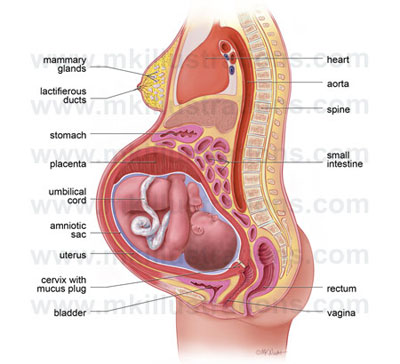 With many pints of blood on hand, it was a tense moment when they opened up her abdominal cavity. They didn’t know what to expect, for this was a rare condition and Dr. Dissanayake in his long 25-year experience had not attended to such a patient. The Sunday Times understands that pregnancies in the abdominal cavity that go beyond 12-20 weeks are rare, occurring only in about one in 30,000 women. Even in them there are foetal anomalies (defects) as there is growth restriction because the abdomen is not meant for a pregnancy, it is the uterus where it should occur, explains House Officer Dr. Suneth Lalantha de Silva who was by Dr. Dissanayake’s side and had to manage Chathurika when she complained of abdominal pain until everything was in place for the operation. With many pints of blood on hand, it was a tense moment when they opened up her abdominal cavity. They didn’t know what to expect, for this was a rare condition and Dr. Dissanayake in his long 25-year experience had not attended to such a patient. The Sunday Times understands that pregnancies in the abdominal cavity that go beyond 12-20 weeks are rare, occurring only in about one in 30,000 women. Even in them there are foetal anomalies (defects) as there is growth restriction because the abdomen is not meant for a pregnancy, it is the uterus where it should occur, explains House Officer Dr. Suneth Lalantha de Silva who was by Dr. Dissanayake’s side and had to manage Chathurika when she complained of abdominal pain until everything was in place for the operation.
As Dr. Dissanayake wielded the scalpel, cut through the abdominal wall and cut the umbilical cord, there was an air of expectancy tinged with tension. “It was a small longitudinal incision in the upper mid-line of the abdominal wall,” says Dr. de Silva shedding light on Dr. Dissanayake’s expertise, adding that it was an amazing sight to see the baby without the water-bag in the abdominal cavity.
When the baby let out her first full-throated cry, the team, doctors, nurses, et al sighed in relief…..the baby was fine. It was a “bloodless” operation in the sense that Chathurika didn’t need any transfusions.
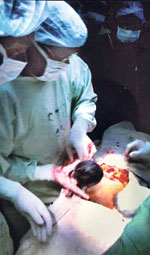 “It was a first for me,” says Dr. Dissanayake as it was for all on the team when they delivered the 2.1 kg baby at 8.51 in the morning.
The team has left the placenta (which is usually expelled during the normal birth process) in its original place because many are the blood vessels linking it to the structures of the abdominal cavity. “We are monitoring and keeping the mother under observation,” says Dr. Dissanayake, adding that the placenta should dissolve and get absorbed to the body. “It was a first for me,” says Dr. Dissanayake as it was for all on the team when they delivered the 2.1 kg baby at 8.51 in the morning.
The team has left the placenta (which is usually expelled during the normal birth process) in its original place because many are the blood vessels linking it to the structures of the abdominal cavity. “We are monitoring and keeping the mother under observation,” says Dr. Dissanayake, adding that the placenta should dissolve and get absorbed to the body.
This was not a Caesarian but a laparotomy, says the Director of the Castle Street Hospital, Dr. Rani Fernando, not only commending her team of Ward 7 and 8 but also the expertise of outstation doctors and the freea state health service due to which Chathurika has been able to give birth to a healthy baby under extraordinary circumstances.
The baby-girl nourished and nurtured in the “wrong place”, the abdominal cavity of her mother, and now snuggling in a cot of the Special Baby Care Unit at the Castle Street Hospital, of course, is oblivious to her trailblazing entry into the world. |

 Propped up on a bed with a few tubes linking her to machines, H.M. Dinithi Chathurika is all smiles. Although she has not held her first-born close, she knows that her baby daughter is well.
Propped up on a bed with a few tubes linking her to machines, H.M. Dinithi Chathurika is all smiles. Although she has not held her first-born close, she knows that her baby daughter is well. 

 With many pints of blood on hand, it was a tense moment when they opened up her abdominal cavity. They didn’t know what to expect, for this was a rare condition and Dr. Dissanayake in his long 25-year experience had not attended to such a patient. The Sunday Times understands that pregnancies in the abdominal cavity that go beyond 12-20 weeks are rare, occurring only in about one in 30,000 women. Even in them there are foetal anomalies (defects) as there is growth restriction because the abdomen is not meant for a pregnancy, it is the uterus where it should occur, explains House Officer Dr. Suneth Lalantha de Silva who was by Dr. Dissanayake’s side and had to manage Chathurika when she complained of abdominal pain until everything was in place for the operation.
With many pints of blood on hand, it was a tense moment when they opened up her abdominal cavity. They didn’t know what to expect, for this was a rare condition and Dr. Dissanayake in his long 25-year experience had not attended to such a patient. The Sunday Times understands that pregnancies in the abdominal cavity that go beyond 12-20 weeks are rare, occurring only in about one in 30,000 women. Even in them there are foetal anomalies (defects) as there is growth restriction because the abdomen is not meant for a pregnancy, it is the uterus where it should occur, explains House Officer Dr. Suneth Lalantha de Silva who was by Dr. Dissanayake’s side and had to manage Chathurika when she complained of abdominal pain until everything was in place for the operation.  “It was a first for me,” says Dr. Dissanayake as it was for all on the team when they delivered the 2.1 kg baby at 8.51 in the morning.
The team has left the placenta (which is usually expelled during the normal birth process) in its original place because many are the blood vessels linking it to the structures of the abdominal cavity. “We are monitoring and keeping the mother under observation,” says Dr. Dissanayake, adding that the placenta should dissolve and get absorbed to the body.
“It was a first for me,” says Dr. Dissanayake as it was for all on the team when they delivered the 2.1 kg baby at 8.51 in the morning.
The team has left the placenta (which is usually expelled during the normal birth process) in its original place because many are the blood vessels linking it to the structures of the abdominal cavity. “We are monitoring and keeping the mother under observation,” says Dr. Dissanayake, adding that the placenta should dissolve and get absorbed to the body. 